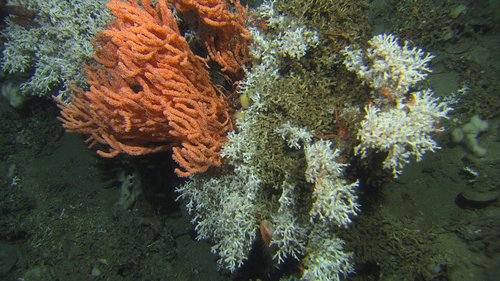
Contact:
cruise leader
Pål Buhl-Mortensen
+47 55 23 85 99
communication advisor
Beate Hoddevik Sunnset
+47 908 21 630

Published: 08.09.2015 Updated: 02.10.2015

The Pearl Chain Reef house several different coral species. The white coral, Lophelia pertusa, is known for building large reefs in the deep ocean off the coast of Norway; it is also an important species at the newly discovered Pearl Chain Reef. The orange coral, Primnoa resedaeformis, is a deep-sea gorgonian octocoral (a "seafan"). Looking closely among the corals, both a squat lobster (Munida sp.) and the big bivalve Acesta excavata can be observed.
Many new coral reefs have been found during this cruise. At one location 24 reefs were filmed with a video camera during a single dive. These reefs are situated like a chain of pearls along iceberg plough marks — long trenches on the ocean floor dug out by icebergs at the end of the last glaciation — hence the name Pearl Chain Reef. This is something that we have not seen before; although, it is well documented that coral reefs often grow on the edges of such plough marks.

This bright pink sea tree coral (Paragorgia arborea) is approximately a meter high. The white coral (bottom left) are live Lophelia colonies growing against the currents.
On detailed maps of the ocean floor it is possible to see how the reefs have started growth at the edges of the plough marks and then extend outward against the direction of prevailing currents.

This section of a multi-beam bathymetry map illustrates how the coral reefs (Korallrev)grow at the edges of iceberg plough marks (Isfjell-pløyemerke). This map was made before the cruise and is part of the bathymetry maps serving as an important background for selecting locations for video investigation.
The bottom is steep in the front of the reefs, growing out towards the middle of the plough mark. Here, the coral reefs grow tall and extend horisontally out from the edge of the furrow. Living corals of such elongated reefs occur only the colonies in the front of the reef, exposed to the currents. The reef’s base consists of dead coral debris, similar to that occurring on the down-current reef “tail”. The corals were observed at approximately 290 meter depths; reefs were around 50-100 meters long and 10-30 meter wide. Based on age determinations for similar reefs at Træna, these new reefs are approximately 5,000 years old. Further studies of material collected at this site will be very useful to improve method for detecting such reefs, to understand how they have evolved, and to determine their importance to local ecosystems.

Redfish (Sebastes sp.) have been commonly observed at reefs studied off Norway.